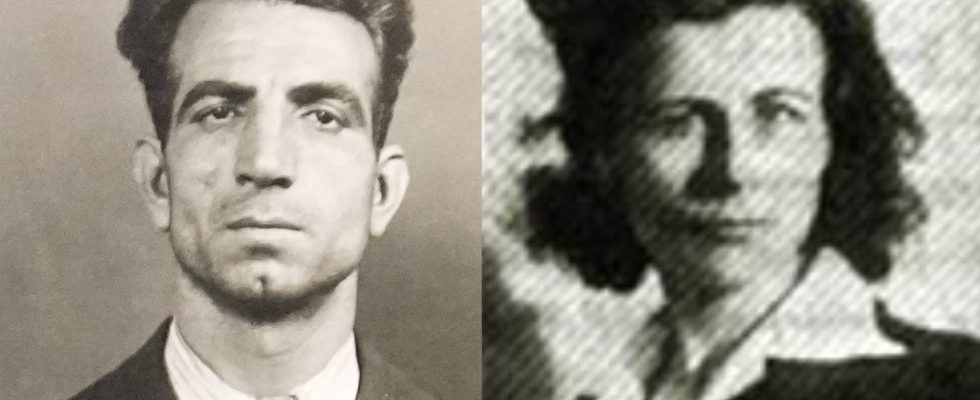Her love story and her journey are closely linked to her activist fight. Armenian communist resistance fighter Mélinée Manouchian will be buried at the Pantheon with her husband, Missak Manouchian, this Wednesday, February 21.
Missak Manouchian will not enter the Pantheon alone on Wednesday February 21, he will be accompanied by his wife, the resistance fighter of Armenian origin Mélinée Manouchian. The couple, whose relationship was “very close” according to historian Denis Peschanski, interviewed by TF1Info, will remain united until death. If she is not pantheonized like her husband, Mélinée Manouchian will be buried in the Republican temple and honored for her participation in the French Resistance.
The lives of Missak and Mélinée Manouchian, née Soukmémian, are punctuated by the same great traumas and stages, starting with the Armenian genocide which affected the country from 1915. He born in Adiyaman, in Anatolia, in 1906, while she was born in Constantinople in 1913, but both were orphaned after the genocide. He joins an orphanage in Lebanon, while she ends up in an orphanage in Greece. But it was to France that their lives took them in 1924 for Missak and her brother, who came to take advantage of the search for labor in France, and in 1926 for Mélinée and her sister. The young girl, then aged 13 and stateless, finished her schooling at a boarding school for Armenian girls and began studying to become an accounting secretary and stenographer.
“We could not remain indifferent to all these murders”
It was not until the 1930s that Missak and Mélinée met. Both involved with the Relief Committee for Armenia (HOC), a pro-Soviet communist organization which campaigns for a rapprochement between the Armenian diaspora in France and Soviet Armenia, they noticed in 1934. But it It was in 1935 that they exchanged for the first time during a dance in 1935, they married a few months later in 1936. Their relationship therefore began against a backdrop of communist commitment and was closely linked to their respective involvement in the Resistance. French, because if the actions of Missak Manouchian are known and praised, Mélinée Manouchian was also fully invested in this period of history.
From 1939, the couple lived to the rhythm of resistance and were most often separated. While Missak was arrested and then released, because he volunteered to join the army, then assigned as a foreign worker in a factory in Sarthe, Mélinée Manouchian remained in Paris, including when the city was occupied, and continued her militant acts. Using her training, she typed and distributed leaflets and newspapers clandestinely. Their commitment went up a notch in 1941 when the couple joined the resistance group of the Immigrant Workforce (MOI), a branch of the CGTU union. Within the group, Mélinée and her husband are responsible for what they call German Work, that is to say the organization of desertions or the enlistment of soldiers of the German army in the Resistance.
The couple reluctantly joined the armed resistance in 1943 by joining the Francs-tireurs et partisans de la Main-d’œuvre émigré (FTP-MOI) for whom Mélinée became a liaison officer, against the advice of her husband who wants to keep her safe and away from the field. At the same time, she decided to abort the child she was expecting with Missak to become fully involved in her militant fight, once again in opposition to her husband’s wishes. “We could have remained hidden, but we could not remain indifferent to all these murders, to all these deportations of Jews by the Germans, because I saw the hand of these same Germans who supported the Turkish army during the Armenian genocide,” she wrote after the war as the TF1Info report.
“I have not been able to rebuild my life: besides, can a life be remade?”
Between November 1943 and the beginning of 1944, it was a new trauma for Mélinée: that of losing the man she loved. The couple saw each other for the last time on November 15, 1943 before the last arrest of Missak Manouchian. The man was executed on Mont-Valérien on February 21, 1944, but his wife did not discover it until several weeks later. In the last letter addressed to his wife, the poet writes: “I therefore beg you to marry after the war, without fail, and to have a child for my happiness, and to fulfill my last wish, marry someone ‘one who can make you happy’. But Mélinée Manouchian will never rebuild her life, clinging to the memory of her husband and their fight for freedom: “By losing him, I lost happiness,” she wrote, adding: “I am lost from then on, don’t surviving only a past which gives me no peace”.
Mélinée Manouchian continued her acts of activism until the end of the war despite the risks; she also hid for a time with the Aznavourians, parents of the man who would become Charles Aznavour. She ended up being naturalized French in 1946, at the end of the Second World War, and volunteered for a USSR program aimed at repopulating Armenia, in accordance with the ideas she defended with the HOC, in 1948. But once in Yerevan, Mélinée Manouchian becomes disillusioned with Soviet policy. She had to wait until the early 1960s to return to Paris and be treated for cancer. Back in France and benefiting from the status of war widow, Mélinée Manouchian continues her actions for the Armenian diaspora and makes it her duty to work in the memory of the resistance fighters, including that of her husband. She also published Missak Manouchian’s poems in the 1950s, as he had asked her in his final letter, and wrote the first biography of her husband. Made a Knight of the Legion of Honor in 1986, she died in 1989 and joined the man she loved all her life in the Parisian cemetery of Ivry.
